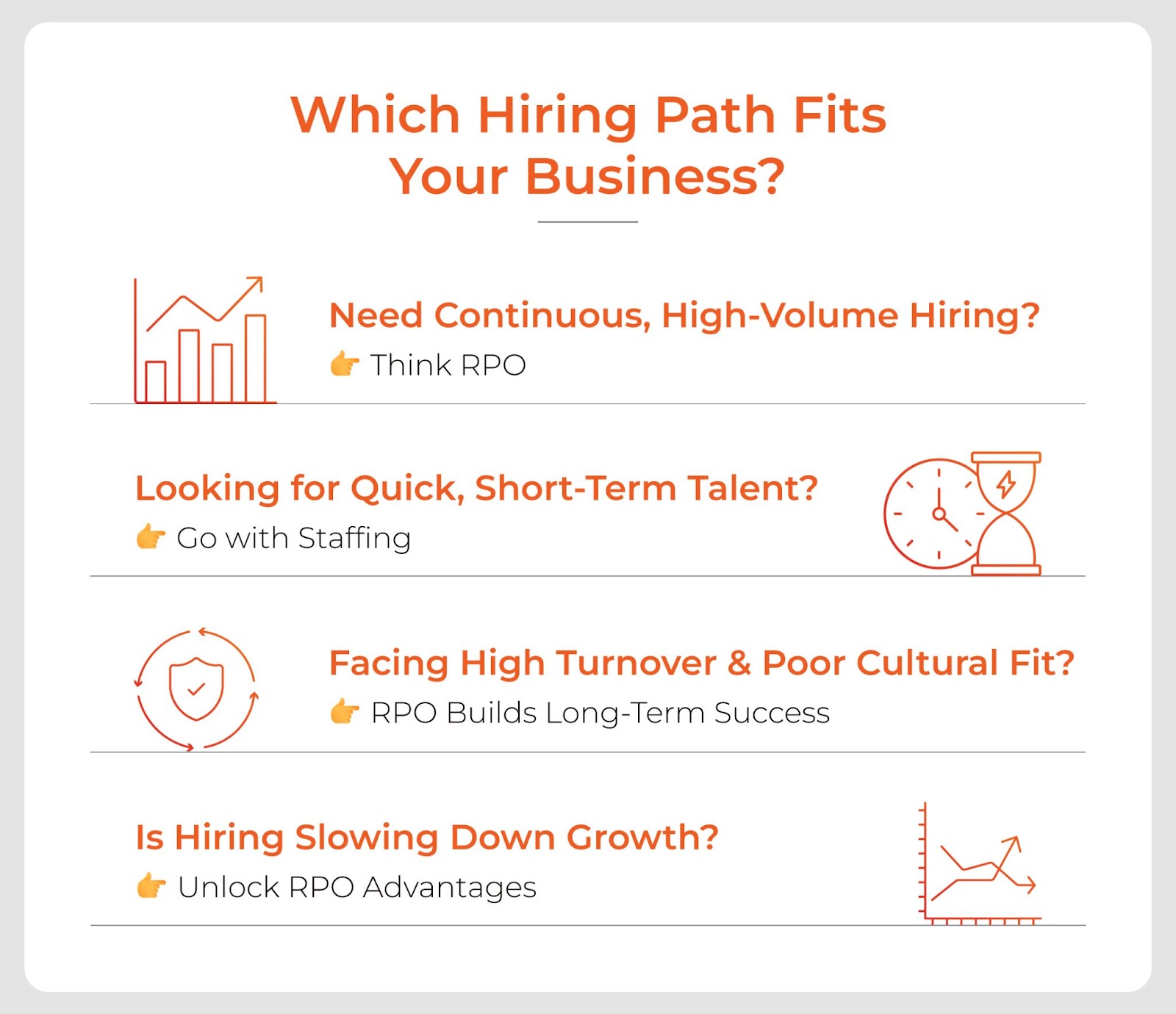Whether you’re scaling a team, covering a sudden resource gap, or building out a new function, how you hire matters as much as who you hire. The truth is that the wrong process can slow you down, burn your budget, or derail the whole project.
And with so many options on the table — internal teams, staffing partners, RPO providers—it’s easy to feel stuck asking: What hiring model actually fits our goals, budget, and urgency?
That’s where the RPO vs. staffing debate comes in. One offers end-to-end recruitment as a long-term strategy. The other is a more tactical, flexible staffing solution tailored to your current workforce needs. Both work, but not always in the same situations.
This article breaks down when, why, and how to choose the right model, so you can hire smarter, not just faster.
What Is RPO in Recruiting?
Recruitment Process Outsourcing (RPO) is a long-term, strategic partnership where an external provider manages part or all of your recruitment process. This transforms how your organization attracts, hires, and retains talent.
RPO services typically include:
- End-to-end talent acquisition strategy
- Employer branding initiatives
- Sourcing and pipeline development
- Technology optimization for hiring workflows
- Advanced reporting and analytics
Unlike traditional recruiting methods that focus on immediate hiring needs, RPO takes a consultative approach. It aligns recruitment with your company’s long-term growth goals and helps you build a sustainable talent pipeline.
Learn more in our comprehensive guide to recruitment process outsourcing.
What is Staffing ?
Staffing services are all about speed and flexibility. Need someone in the door next week? That’s staffing. These services typically focus on filling contract, temporary, or short-term roles. Think of it as calling in a specialist for a high-stakes rescue mission: solve the immediate problem, then move on. It’s a tactical fix, not a long-term strategy.
Common use cases for staffing include:
- Seasonal surges
- Project-based roles requiring niche expertise
- Quick replacements to cover sudden attrition
Staffing shines when timelines are tight and workforce gaps need closing ‘yesterday’. But because the focus is on speed, it’s not always built for long-term cultural alignment or retention. If you’re looking to build a talent pipeline or reduce turnover, staffing alone may not check all the boxes.
The Key Differences (RPO vs. Staffing)
RPO vs. staffing isn’t about good vs. bad. It’sabout what your business really needs.
| Feature | RPO | Staffing Services |
| Focus | Strategic, long-term hiring | Tactical, short-term placements |
| Engagement Model | Partnership-based | Transactional |
| Hiring Volume | High-volume, ongoing needs | Immediate, ad-hoc needs |
| Candidate Quality | Focus on cultural fit and retention | Skill-fit for immediate tasks |
| Technology Support | Advanced ATS, analytics, reporting | Limited or no tech involvement |
| Scalability | High (supports business growth) | Moderate (fills urgent gaps) |
Let’s break it down with a simple analogy:
Staffing is like calling a rideshare when you need to get somewhere fast. It’s quick, efficient, and gets the job done when time is tight or plans change.
RPO is like hiring a personal driver. There’s more coordination involved, but over time, it gives you consistency, reliability, and someone who knows your routes, preferences, and long-term needs.
Both get you from point A to point B. The right choice depends on how far you’re going and how often you’re traveling.
The Cost Difference Between RPO and Staffing
Let’s be honest, costs are always part of the conversation. But looking only at upfront expenses does not tell the full story.
- Staffing services offer a more immediate and visible cost structure: You pay per placement or per contract. For short-term roles or urgent project-based needs, that’s often the most efficient route. But in high-turnover environments or when roles need to be refilled repeatedly, hidden costs like onboarding time and ramp-up loss can start to add up.
- RPO services, on the other hand, involve more upfront planning and investment. For organizations with ongoing hiring needs, the long-term benefits, like reduced time-to-hire, stronger talent pipelines, and lower attrition, often lead to a more sustainable cost-per-hire over time.
So what’s the right move? If you’re navigating a seasonal spike or a sudden resourcing gap, staffing delivers speed and flexibility without long-term overhead. But if hiring is central to your growth strategy, an RPO solution helps build a scalable, cost-efficient recruitment engine.
Flexibility Or Scalability? What’s Better?
- Staffing services offer immediate flexibility. Need 20 temp workers next week? Done. But this flexibility is often reactive, designed for short bursts of demand rather than sustained growth.
- RPO services provide hiring at scale with foresight. Tech-enabled RPO partners like SPECTRAFORCE use AI and machine learning to streamline recruitment workflows, improve candidate experiences, and forecast future talent needs. As your business grows or enters new markets, they ramp up hiring seamlessly, without sacrificing quality or speed.
RPO vs. Staffing: What Fits Best?

If you’re still on the fence, ask yourself these questions:
- Are we facing ongoing, high-volume hiring needs? → RPO is your answer.
- Do we only need quick, temporary hires for specific roles? → Go with staffing services.
- Are we struggling with high turnover and poor cultural fit? → RPO can help build a sustainable hiring strategy.
- Is hiring becoming a bottleneck to business growth? → Time to explore the advantages of RPO.
Remember, choosing between RPO vs. staffing isn’t always an either-or decision. Some organizations successfully combine both models to address different hiring challenges.
To Conclude
Talent acquisition has never been easy, and it likely will not. The competition for skilled professionals is intense, hiring timelines are shrinking, and the pressure to improve retention is higher than ever. In this situation, relying solely on traditional recruitment methods may no longer be enough.
Investing in RPO services can unlock significant advantages if your business is in its growth phase or undergoing a transformation. From improving employer branding to building a future-ready talent pipeline, RPO empowers you to think long term.
That said, there’s benefit in leveraging staffing services when you need quick wins. Just remember, speed with strategy is a winning combination.
Looking for smarter, faster hiring solutions? Connect with SPECTRAFORCE today for a custom strategy that suits your needs.
FAQs
1. When should a company use RPO instead of staffing?
If your organization has ongoing or high-volume hiring needs and wants to improve long-term talent acquisition processes, RPO is the better choice. It’s also ideal when cultural fit and retention are top priorities.
2. Is RPO more cost-effective than staffing?
While RPO has higher upfront costs, it offers better long-term savings by reducing turnover, improving time-to-hire, and enhancing recruitment quality. Staffing is cost-effective for short-term or project-based needs.
3. Can RPO providers handle temporary staffing too?
Yes, many RPO providers offer hybrid solutions that include temporary staffing. However, their real strength lies in strategic, long-term hiring solutions.
4. Which is better for high-volume hiring: RPO or staffing?
RPO is better suited for high-volume hiring as it focuses on building scalable talent pipelines and improving hiring efficiency. Staffing services are better for immediate, short-term needs.



